Our everyday lives, economy, and well-being are built on biodiversity, which is the foundation of life. However, due to increasing population and growing economic activities, biodiversity is seriously declining. How can we conserve and restore ecosystems? This is one of the key challenges facing human society.
OMRON established its Biodiversity Policy in 2010 and has been working to conserve biodiversity.
In December 2022, the Kunming-Montreal Global Biodiversity Framework was adopted during the fifteenth Conference of the Parties (COP15) on the UN Convention on Biological Diversity. Supporting the Framework’s vision of coexistence with nature and nature positive, OMRON revised its Biodiversity Policy in 2024. In making the revision, we referred to such sources as disclosure recommendations and guidance by the Task Force on Nature-related Financial Disclosures (TNFD), a framework for disclosing risks and opportunities related to nature capital.
The OMRON Biodiversity Policy is a subordinate policy to the Environmental Policy approved by the Board of Directors. It has been reviewed and approved by the Sustainability Committee chaired by the Sustainability Executive Officer.
(Revised: July, 2024)
The Yasu Office is in Shiga Prefecture, where Lake Biwa, also known as the "mother" lake, is located. Until the end of September 2021, the plant manufactured semiconductors and MEMS, with the wastewater discharged into a river after purification for environmental concerns. Using this wastewater effectively, we created a biotope*1 in 2011 to protect and propagate the striped bitterling*2 fish, which is listed as a critically endangered species by the Ministry of the Environment. This project also contributed to environmental education for children through nature observation tours at nearby childcare centers and elementary schools. As a result of these efforts, the company received the highest certification, a three-star rating, under the Shiga Biodiversity Initiative Certification Program. This is a certification system in which Shiga Prefecture evaluates biodiversity conservation and the sustainable use of natural resources.
In October 2021, the semiconductor and MEMS businesses were transferred to another company, as was the biotope site, preventing the use of the biotope to address biodiversity as we have in the past.
The BBN*3 is a joint effort by seven companies based in Shiga Prefecture (including OMRON) to survey, conserve, and communicate information on 100 species of dragonflies confirmed so far in the prefecture, using dragonflies and their deep relationship with water as a common indicator organism. In fiscal 2021, we held a dragonfly observation and specimen-preserving workshop for local children. We also co-hosted a month-long exhibition with the Lake Biwa Museum, providing an opportunity to inform many people about our past efforts.
These activities were recognized by outside parties, and won the grand prize in the education and dissemination category of the Nature Conservation Society of Japan Awards 2021.
As an activity unique to the Yasu Office, the office focuses on the conservation and restoration (monitoring, protection and propagation, and habitat improvement)of a rare species of dragonfly, Sympterum kunckeli (Red Dragonfly). In recent years, the numbers and habitats of the red dragonfly have been declining in Shiga Prefecture, but we have confirmed that the dragonflies pass over the Yasu Plant every year, and we continue to conduct surveys of migration. We have also created a container biotope at the Yasu Office to create a breeding site and to protect and propagate the species using collected eggs.
Through past efforts, we have learned that the green spaces of our business locations become part of local nature. We will continue to make use of our green spaces to conserve local animal populations, pursue the conservation of rare and locally native species, and expand the circle of environmental conservation in cooperation with local communities and other entities.

Yasu Office mascot
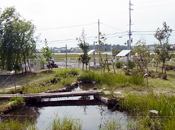 "Pond of bitterlings" biotope
"Pond of bitterlings" biotope
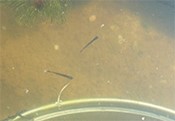 Successful breeding of juvenile bitterlings
Successful breeding of juvenile bitterlings
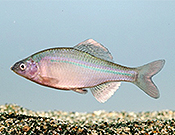 Striped bitterling
Striped bitterling
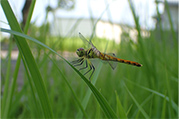 An endangered red dragonfly
An endangered red dragonfly
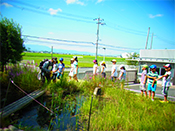 Nature observation tour
Nature observation tour